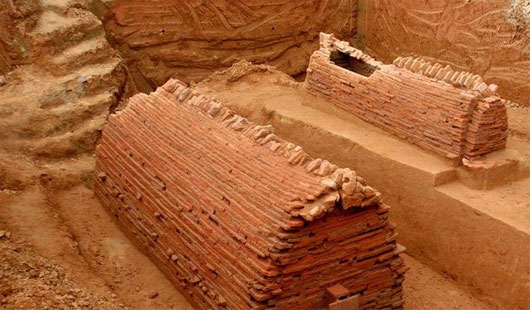Many tombs have been discovered dating back over 6000 years
Archaeologists have discovered many burial tombs of primitive people dating to more than 6,000 years at Na Mo cave, Huong Ne commune, Ngan Son district, Bac Kan province.
This finding has contributed new insights into prehistoric research in Bac Kan in particular and Vietnam in general.
Associate Professor Dr. Nang Nang Chung, Institute of Archeology, who chaired the excavation said: Na Mo Cave is a relic of the residence of many generations of primitive inhabitants. The earliest resident class of the Hoa Binh-Bac Son cultural inhabitants is late dating back about 6,000-7,000 years ago.

Artwork: VNA
The late residency class belongs to the post-neolithic period of the new stone age, with the age of 3,500-4,000 years ago. Based on the absolute chronological analysis of the shells attached to the grave, graves are more than 6,000 years old.
Archaeologists have collected many samples of pollen spores to study the ancient ecological environment in the area.
6 tombs were found, of which 4 tombs were completely exposed. The stone walls are scattered on the surface, the bottom is a broken human skeleton. Two graves are attached to the stone chisel tool like burial objects.
Especially note that no traces of skulls or human teeth were found. Those who excavate the hypothesis, this phenomenon is related to the "skull hunt" - a rather common practice of primitive people in Southeast Asia?
Besides, archaeologists discovered hundreds of archaeological relics, mostly stone. The monument has 2 cultural classes that develop directly on each other, without separation classes. The early culture class contained many pebble stone labor tools bearing the characteristics of Hoa Binh-Bac Son technology.
Aboriginal (red mineral stones) were also found. Primitive people often grind the abundance into powder mixed with water applied to the living and dead to decorate.
The late culture class has a grinding ax, thick coarse pottery is hand-molded, a low degree of burning, the outside is not decorated with patterns. It is noteworthy that a small cylindrical object with a hexagonal section is polished on a very beautiful quartze stone. This may be the jewelry of prehistoric people.
- Discover 10 ancient tombs dating back more than 3,000 years
- Egypt discovered 10 tombs of 2,500 years filled with mummies
- Egypt discovered the tomb of the Pharaoh era writer
- Discovered 600 ancient tombs dating back thousands of years
- Discovering ancient Vietnamese tombs dating back thousands of years
- China excavated the tomb of the Liao dynasty dating back 1000 years
- Khai excavated an ancient tomb for 300 years in Hanoi
- The octagonal tomb of the Chinese couple 700 years ago
- Discover hundreds of 6,000-year-old mummies in 7 Egyptian catacombs
- Discovered the tomb of the mysterious Egyptian queen
- Mexico discovered an ancient burial site dating back to 800 years
- Discover the tomb of the ancient Egyptian wine maker in Luxor
 Discovered an ancient centipede fossil 99 million years old
Discovered an ancient centipede fossil 99 million years old Discovered bat-like dinosaurs in China
Discovered bat-like dinosaurs in China Discovered a 200-year-old bronze cannon of the coast
Discovered a 200-year-old bronze cannon of the coast Discover 305 million-year-old spider fossils
Discover 305 million-year-old spider fossils